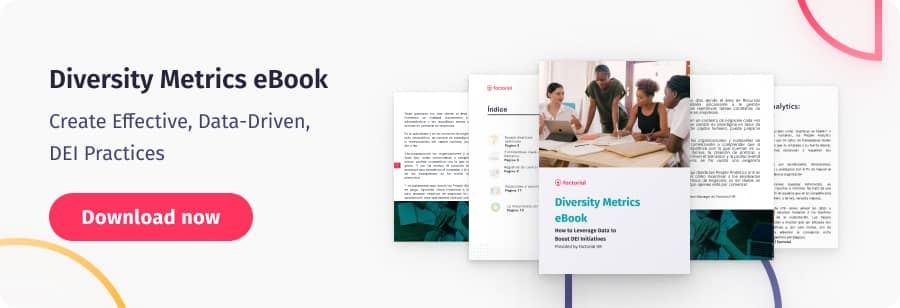In an age when it’s becoming increasingly clear that we can and must do better, companies must shoulder a broader social responsibility. This means working to promote diversity, equity, and inclusion while abolishing discrimination and inequality within the workplace.
However, becoming a positive agent of change won’t happen on its own. Too often, organizations look to corporate buzzwords and vague promises to set them on the right path. That won’t do it. Instead, companies must implement diversity, equity, and inclusion policies and promote cultural competence in the workplace. They must provide the commitment and action necessary to drive progress.
In this blog, we’ll look at diversity equity and inclusion, including what it is, how it can benefit organizations, and how you incorporate DE&I initiatives into your company.
- The Definition of Diversity, Equity, and Inclusion
- Benefits of DE&I
- Diversity, equity, and inclusion in the workplace examples
- Implementing DE&I Training
- Creating a DE&I Mission Statement
- Rely on the Numbers
- HR Reports Made Easy with Factorial ✅
What Is Diversity, Equity, Inclusion (and Belonging)?
Diversity, equity, inclusion, and belonging (DEIB) is a strategic approach that organizations adopt to create a more diverse and inclusive workforce. It aims to create a working environment that benefits all employees, regardless of gender, ethnic background, socioeconomic background, and mental and physical ability, among others.
It’s a natural progression of earlier diversity and inclusion (D&I) strategies and serves to empower historically underrepresented employees to fulfill their professional potential.
The term is grouped as one yet, while the words overlap and interconnect, each is also an individual concept. Let’s take a look at the diversity equity and inclusion definition in closer detail.
Diversity
“Diversity” does not refer to a person on the simple basis that people cannot be “diverse.” Rather, diversity refers to the makeup of the organization. Cultivating a diverse workforce means ensuring that there’s a diverse representation of people working there, including people of different races, genders, sexual orientations, and social backgrounds.
Equity
People often use equity as a synonym for ‘equality,’ but there are key differences. In a working environment, ‘equality’ would give the same access to tools, resources, and opportunities to all employees. ‘Equity’ recognizes that not every employee will thrive under the same conditions and promotes an individualistic approach that works to meet each individual’s needs.
Equity also acknowledges that institutional barriers prevent some employees from getting ahead and that some employees (or candidates) receive institutional advantages that make it easier for them to succeed.
For instance, a Stanford University study found that a person named “John” would be much more likely than a person named “Jennifer” to get a job, even if their resumes were identical. In this case, John’s gender was an advantage, and Jennifer’s gender was a barrier. Among other things, equity aims to initiate processes that remove unconscious bias from the decision-making process.
Inclusion
We’re going to put this definition in the hands of Verna Myers, who describes inclusion more poetically than we can. She says, “diversity is being asked to the party. Inclusion is being asked to dance.”
Diversity refers to representation. Inclusion is about creating an environment where everyone, and especially marginalized peoples, feels valued, supported, and celebrated. This can take many forms, including ensuring that everyone’s voice and opinion — and not just those from dominant groups —is heard. Or it could involve creating a prayer or meditation room within the workplace and celebrating varied cultural events as a team.
A good starting point for improving your company’s inclusivity is to ask questions such as:
- What is the workplace experience like for employees from non-dominant groups?
- How might our work culture and practices alienate certain employees?
- Are managers well versed and encouraged to adopt inclusive leadership practices?
Belonging
While discussing diversity, equity, and inclusion in the workplace, it is also important to consider the term “belonging”. In some respects, “belonging” is easily confused with the concept of “inclusion”. However, there is an important difference between the two. Think of a time when you felt as though you were an integral part of something bigger. This feeling of being valued and appreciated within a community or team is exactly what the “B” stands for in DEIB. When it comes to changing the culture of the workplace, belonging can make all of the difference.
Many companies try to put new plans and strategies in place to improve their DEI practices, such as diversity trainings and employee resource groups. Although these efforts can help, it is important to look at leadership tactics and the workplace culture on a deeper level and make sure that team members feel that they are valued parts of the community. For this reason, taking the steps to cultivate a culture of belonging is absolutely crucial to improved DEIB practices.
How Diversity, Equity, and Inclusion Benefits Organizations
By law, employees are protected from disparate treatment discrimination and adverse impact in the workplace. Aside from the legal obligation, there’s an obvious moral case for DE&I. For the world to prosper, we must dismantle and abolish the historical barriers and other institutional factors that have placed non-dominant groups in a disadvantaged position.
While DE&I can look different at every workplace, ultimately having a diversity workplace is beneficial for the whole organization.
- Diversity drives productivity and innovation: Having an equal gender distribution is actually linked to meeting higher revenue. This means that organizations that invest in diversity, equity, and inclusion policies not only cultivate a safe working environment, but also cultivate an atmosphere of motivated workers which creates a positive ROI.
- Increased motivation: Having a team of employees from different backgrounds and perspectives fosters a positive workplace which in turn increases productivity and motivation.
- Retained talent: DE&I policies can also prevent high turnover rates. It can aid the recruitment process and help keep talent once they’re on board.
According to an American Progress study, some two million Americans leave their jobs due to unfairness and discrimination each year, while a Catalyst poll found that 35% of an employee’s emotional investment in their work is connected to their feeling of inclusion.
The same Catalyst poll found that diverse organizations outperform non-diverse organizations in metrics including creativity, openness, understanding consumer interest and demand, problem-solving, and brand reputation. That’s a lot of good that can follow from simply doing the right thing.
Diversity, Equity, and Inclusion in the workplace examples
Some examples of DE&I in the workplace are:
- Using inclusive language in your job descriptions, provide pay transparency, and ensure accessibility for everyone to apply.
- Offer flexibility to your employees. This could be hybrid schedules, offering parental leaves, access to mental healthcare, or providing subscriptions to gyms or studios to encourage physical health.
- Remove all barriers preventing employees from obtaining promotions or opportunities. This means guaranteeing that each employee has a fair opportunity and recognizing the socioeconomic or health related situations that would require some accommodation. This shows your commitment to diversity, equity, and inclusion by providing these accommodations.
Diversity, Equity, and Inclusion Training
Providing diversity, equity, and inclusion training will be crucial in the journey toward a more open and inclusive workplace. While you should endeavor to keep things generally positive, it’s also true that lessons may have to be challenging/uncomfortable. It’s how progress happens.
A training course or workshop might include the following elements:
- Explaining the definitions, differences, and overlap of diversity, equity, inclusion.
- Sharing examples of discrimination or asking employees to share their own experiences (without any pressure to do so, of course).
- Looking at unconscious bias and its effect on underrepresented groups.
- Raising awareness of microaggressions and harmful language (for example, asking someone where they’re from because of their appearance, assigning a nickname to a person rather than learning how to pronounce their name, etc.)
- Encouraging employees to stand up to inappropriate behavior, and teaching the diversity equity and inclusion best practices for doing it.
- Including disability awareness training as a way to tackle ableism in the workplace.
How to Create a DE&I Mission Statement
A passive approach will not lead to a more diverse and inclusive company. It takes action. A diversity equity and inclusion mission statement can function as a guiding principle that stakeholders use during the decision-making process to ensure each decision will enhance diversity and inclusivity.
A diversity, equity, and inclusion policy doesn’t have to be lengthy; in fact, the best are short and easy to read. It should simply reflect your commitment to the cause. This statement should be used during the recruitment process, to ensure that bias against applicants’ gender, race, ethnicity, age, and or sexual orientation will not be practiced.
Check out Google’s diversity equity and inclusion statement as an example:
Our accelerated approach to diversity and inclusion
Google’s mission is to organize the world’s information and make it universally accessible and useful. When we say we want to build for everyone, we mean everyone. To do that well, we need a workforce that’s more representative of the users we serve. That’s why we’ve embraced a refreshed and accelerated approach to diversity and inclusion.
Catchy headline, short text, easy to read. In just sixty-three words, the company has set the standards of its commitment to diversity and inclusion and made itself accountable.
Mission statements work best when they’re easily accessible. Share yours on your websites, in your office, and within your employee portal software for all to see.
Back-Up Your DEI Initiatives With Cold, Hard Math
When implementing DE&I initiatives, don’t just talk the talk. Make sure that your business is also prepared to walk the walk. Prepare key performance indicators (KPIs) and metrics for measuring diversity, equity, and inclusion in your workplace. These will help keep leaders accountable and help drive progress.
In order to set effective KPIs, you need to dig deep into existing data. Run HR reports to investigate retention rates of historically marginalized groups. Do they tend to leave earlier than their non-marginalized counterparts?
How will you get these employees to stick around longer? Talk to current employees and see what you need to do to retain talent. Make sure you’re also looking into recruitment, promotion, and development metrics. These things have a big effect on employee engagement and retention.
Set a concrete goal for improving the retention rate among marginalized by X% over the next year. Break this into smaller, more achievable steps and measure progress regularly. The path to DE&I is through responsibility, accountability, and commitment.

Final thoughts to Improve Diversity, Equity, and Inclusion Efforts
One company’s commitment to DE&I will not be enough to overcome centuries’ worth of systematic oppression and deeply ingrained prejudices and discrimination. That’ll take a coordinated, herculean effort from parties and players that extend far beyond your organization.
But your commitment to improvement will be a valuable and notable step that can energize everyone connected to your company and inspire others to do better. The world moves forward when people and organizations make it so. By making diversity, equity, and inclusion part of your operations, you’ll be doing your small bit in the name of progress. And if all companies and people do that, then the future will look much brighter than the past.



